Knotting is a traditional Korean craft widely used to decorate furniture, clothing, ceremonial goods and other household articles. Park Seon-keung, an instructor for heritage transmission with almost 40 years’ experience, inherited her family business and is working to enhance its modern appeal while preserving the traditional craft.
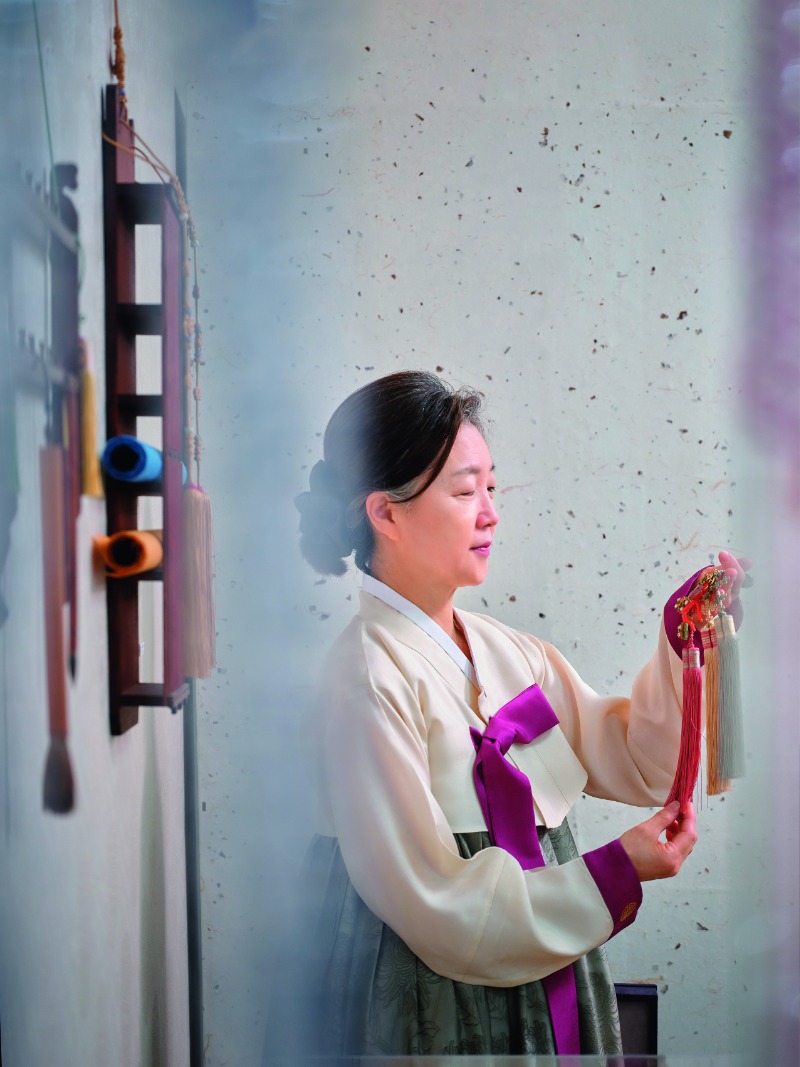
An instructor for heritage transmission with almost 40 years’ experience, Park Seon-keung follows the legacy of her mother and her grandparents, who were all traditional knotting artisans.
Maedeup, a traditional Korean craft producing knotworks of various forms using twisted silken cords (kkeunmok or dahoe), serves both practical and decorative purposes. According to the “Great Administrative Code” (Daejeon hoetong, 1865), a compendium of administrative rules and practices of the late Goryeo Dynasty and the subsequent Joseon Dynasty, the court of Joseon hired a master artisan for each of the knotwork procedures, as each one required a high level of skill and care.
In the old days, knots were essential accessories to accentuate the beauty of hanbok. The robes that men wore for outings (dopo) were given a stylish finish by hanging a knot tassel from thebelt. Such tassels were also indispensable for men’s formal hats (gat), hand fans, and pouches (bokjumeoni). Colorful knot tassels would decorate the drapes of palanquins, and knots with longer fringes were attached to musical instruments like drums and fiddles to give them ceremonial dignity. Koreans used knots on various occasions throughout their lives. At the first birthday party, a baby would wear a waist band decorated with knotting. Prior to marriage, the bridegroom’s family would send a letter to the bride’s house with basic information on the man’s birth (sajudanja), and this letter was tied with a knot depicting linked hearts (dongsimgyeol). Upon death, one’s funeral bier would be adorned with long tassels with exquisite knots.
A Natural Decision
Park, who took over the family business from her mother, is a “successor training” instructor, just one step short of becoming a master artisan herself. For her, the century-old knotting tradition, once on the verge of extinction, represents the craft of three generations of her family’s history.
“Gwanghui-dong in Seoul, where my grandfather was born and raised, was a village of knot makers until the 1930s. Belonging to the youngest generation there, he was awarded the title of Master Artisan when maedeup was designated as national heritage in 1968, rekindling the embers of the traditional craft. Times have changed, and many of the procedures have been mechanized, but I know I have to work hard so as not to dishonor the artisans who did their best to preserve the traditional methods,” Park says.
Dressed in hanbok, which suits her small physique so well, Park speaks with determination. She majored in dance at college but decided to become an artisan early on, evidently influenced by her family environment. Born in 1964, she started official training under her grandmother at age 19. Her mother also joined in and taught her with the rigor of a perfectionist.
“Knotting requires much manual work, so there are always little things to ask for help with. As a girl, I was so calm and good with my hands that I was often called to do small chores,” Park recalls. “It was not that I wanted to learn the craft from the start, but I came to accept it as my calling as I grew up. It suited me to work alone, taking charge of the entire process of twisting threads, tying knots, and creating various designs. Concentrating on the work clears my mind and comforts me.”
Tying knots begins with preparing the silken cords, a complicated and painstaking procedure. Park explains, “Starting with spinning skeins of raw silk threads, there are five or six steps in preparing the cords, each requiring great skill. Obtaining the exact same color from every dyeing session is also difficult. As knotting starts and ends at the center of the desired knot, you have to think ahead about how tosymmetry and make the front and back exactly the same. All in all, it’s a very precise job with little room for error.”
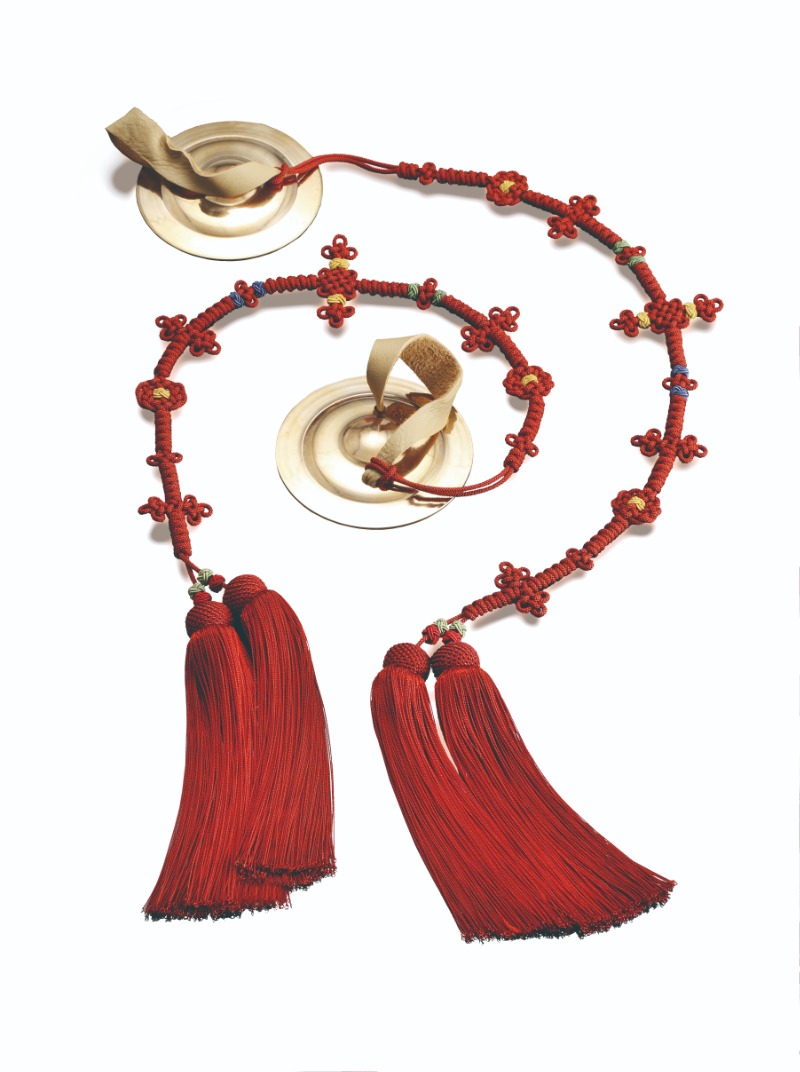
Traditional knots were used to decorate personal accessories as well as household articles and musical instruments. Hyangbal, a traditional Korean percussion instrument, was decorated with long s of knots and tassels.
Courtesy of Park Seon-keung
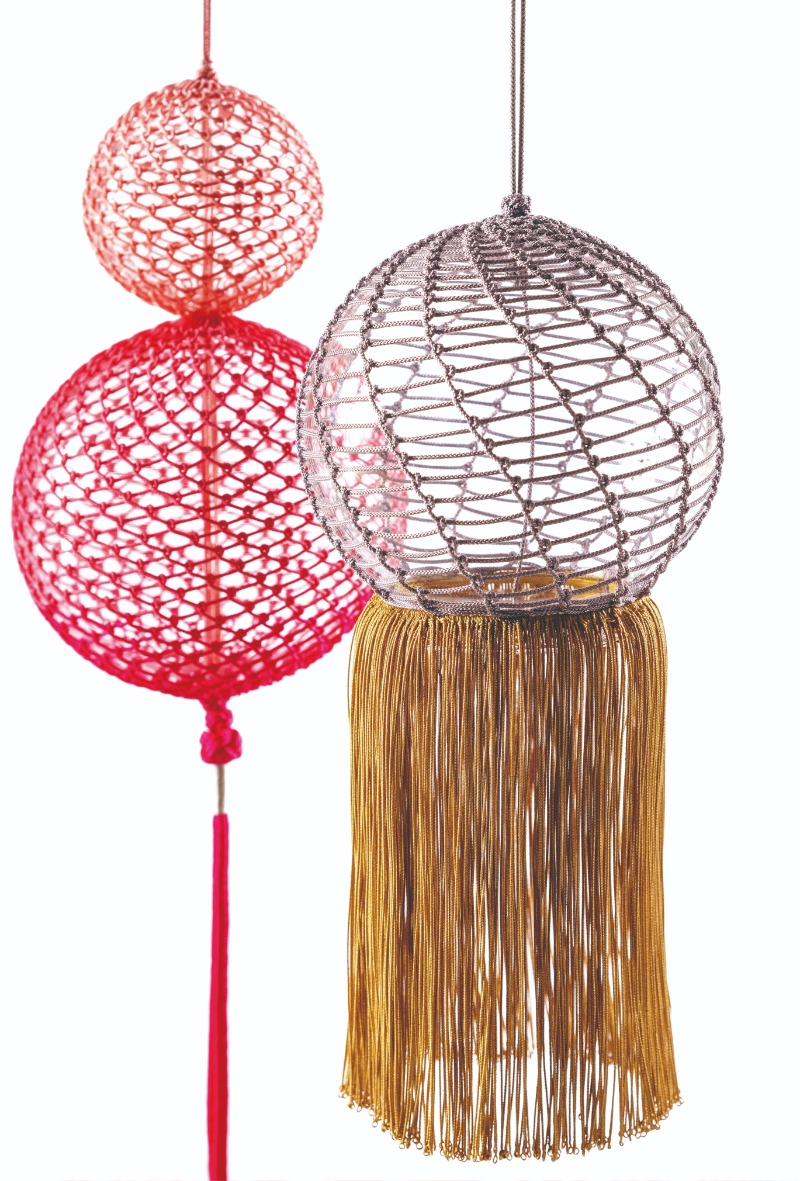
Park collaborated with textile artist Shin Ye-sun to produce these ornaments presented at the Craft Trend Fair and the Maison&Objet trade show.
Courtesy of Park Seon-keung
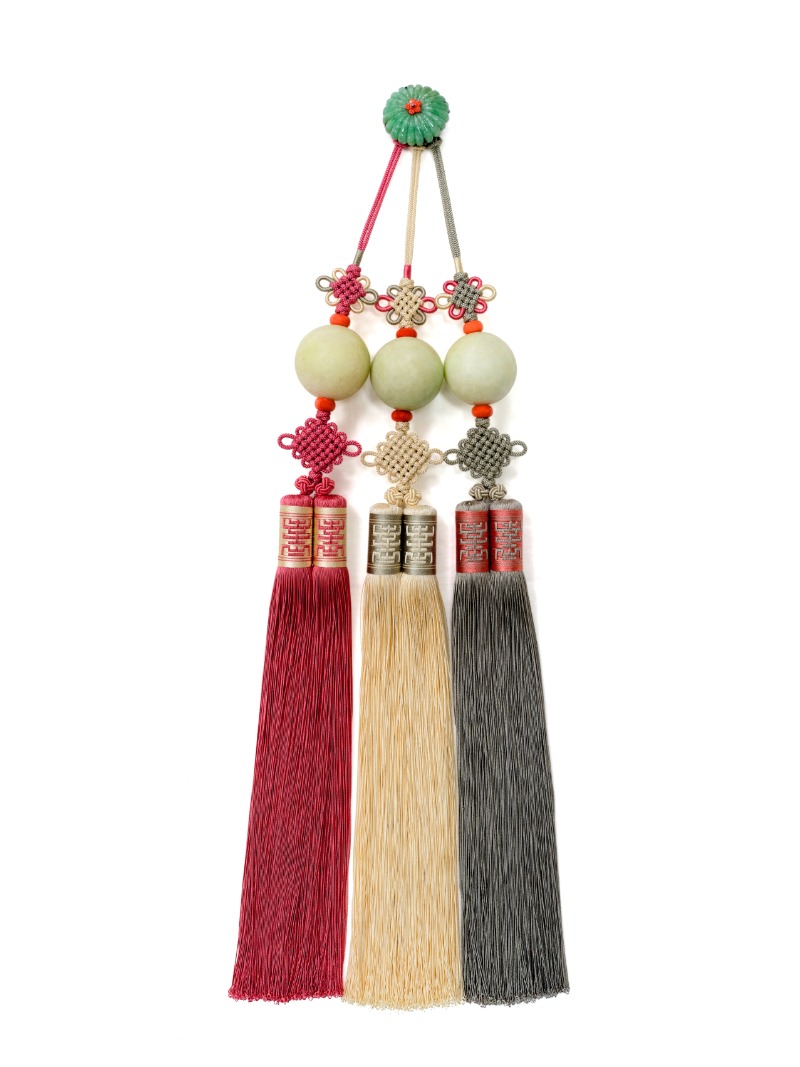
This three-part pendant with jades is made with the chrysanthemum knot, cloverleaf knot, ring knot and others. Knotted pendants, called norigae, were hung on a woman’s jacket ties or skirt, accentuating the beauty of traditional Korean clothing.
Courtesy of Park Seon-keung
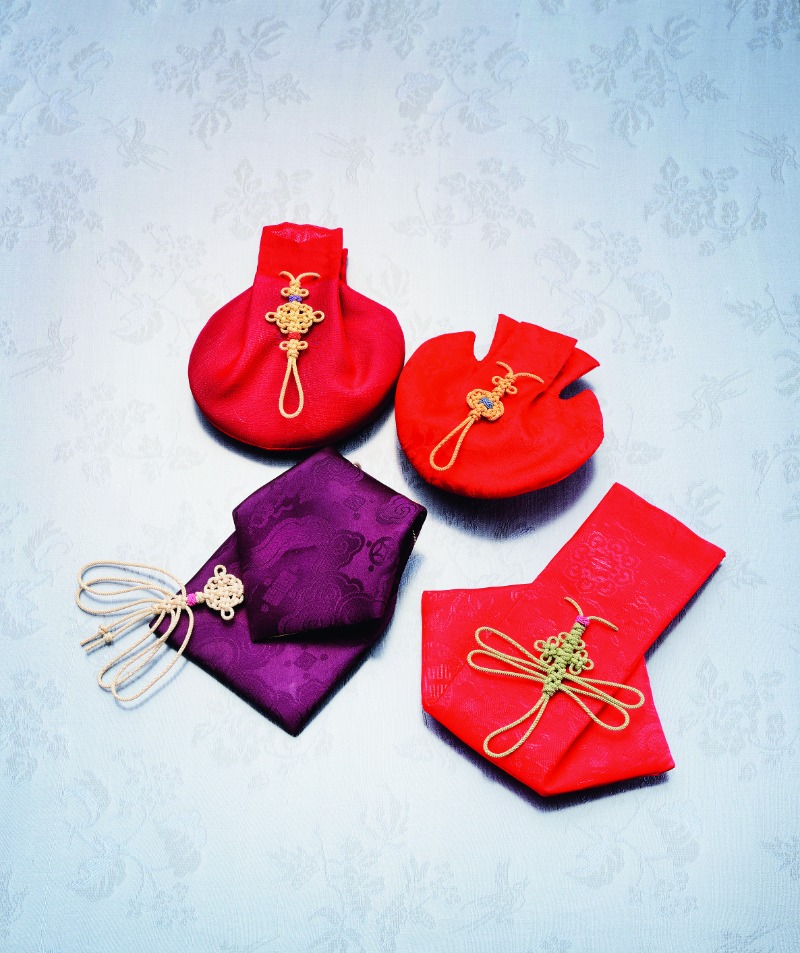
Pouches adorned with various knots, including the dragonfly knot. Holding sundry personal items and hung from the belt, pouches were an everyday necessity for men and women. Women’s pouches were made of colorful fabric and decorated with elaborate knots and tassels, while men’s were simpler without too much decoration.
Courtesy of Park Seon-keung
Product of Endurance
There are over thirty types of knots of different designs, mostly named after animals and plants, including the tortoise, dragonfly, chick, butterfly, bee, chrysanthemum, plum blossom and lotus, among others. The tassels combined with the knots are termed the same way, for example, “octopus-legged tassels” with strands diverging into many branches, “strawberry tassels” with globular heads, and “cylindrical tassels” with tubular heads.
“To make a norigae, a pendant hung on a woman’s jacket ties or skirt, it takes at least ten days, or several months for a large piece. Every single strand of the tassel is made by twisting silk threads hundreds of times,” Park says. Knot craft is an art of lines, practiced with endurance and perseverance. Each of the three Northeast Asian countries has its own traditions. While Chinese knots are highly elaborate with a wide array of designs, the Japanese craft lays more emphasis on the functionality of knotted items rather than the decorativeness of the knots themselves. On the other hand, Korean knots boast beautiful lines formed by tying knots with cords of the same color and attaching long fringes.
“I’m often asked if I’m not bored with tying knots all my life. I sometimes find it difficult, but never boring,” Park says. An artisan who is bored with their work cannot be called a true artisan, however skilled. That Park has been able to dedicate herself to the craft for almost forty years, without thinking of doing anything else, must be due to her love of her work rather than luck or even talent. “One of my clients has ordered pieces from me almost every year. I wondered if she used them as presents. But she said, no, she framed and hung them on the walls to look at them anytime, taking them out whenever she needed them on special occasions. I was so pleased and encouraged by that answer,” she says.
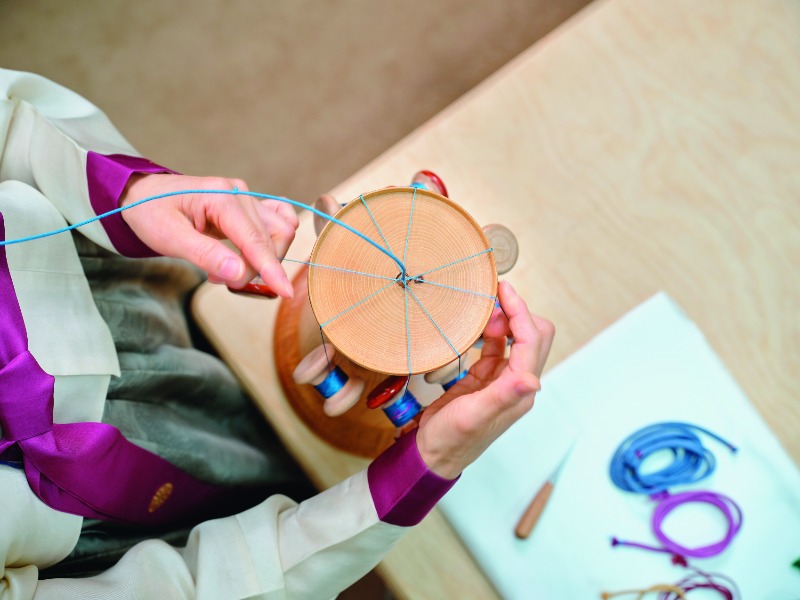
Park twists multiple strands of silk thread using a tool designed for the purpose. The twisted silken cords are the main material for traditional Korean knotting
Communicating with the Times
Apart from preserving tradition, Park is also keen on adopting modern aesthetics in her art. Her collaboration with textile artist Shin Ye-sun, creating ornaments of glass balls in knotted netting, was highly acclaimed at the Craft Trend Fair (2018, 2019), held at Coex in Samseong-dong, Seoul, and at the Maison&Objet trade show (2019, 2020), held at the Paris Nord Villepinte exhibition center. Behind the effort to popularize knotting is her awareness that the craft has survived by communicating with the times. She learns life lessons from her art. “If you make a mistake even with just a single thread, you have to start all over again. Ignoring a small mistake will ruin the entire project. It is best to unravel it and start over.”
When she decided to become an artisan at around the age of 20, Park thought she herself had chosen the craft. Looking back, however, it dawned on her that the craft had chosen her, and she is glad that her life turned out that way.
“Being a traditional artisan can be very lonely, but I was lucky to have my mother watch over me. Recently, there has been an increase in orders for knotworks, so both my brother and sister have left their jobs to work with me as certified trainees. I’m also very fortunate to have my three daughters showing talent and enthusiasm for the art,” she says.
While many traditional artisans are struggling to prevent their craft from being discontinued, Park and her siblings are walking the same path, and her daughter is poised to succeed the family business. In her workshop at the National Intangible Cultural Heritage Training Center in Samseong-dong, her knotworks are displayed along with those of her mother (Master Artisan Jung Bon-seop), her older brother (Park Hyung-min) and her younger sister (Park Seon-hee). Their works look similar but differ in subtle ways, which seems to reflect their partnership, each pursuing their own aesthetics while respecting each other’s styles.
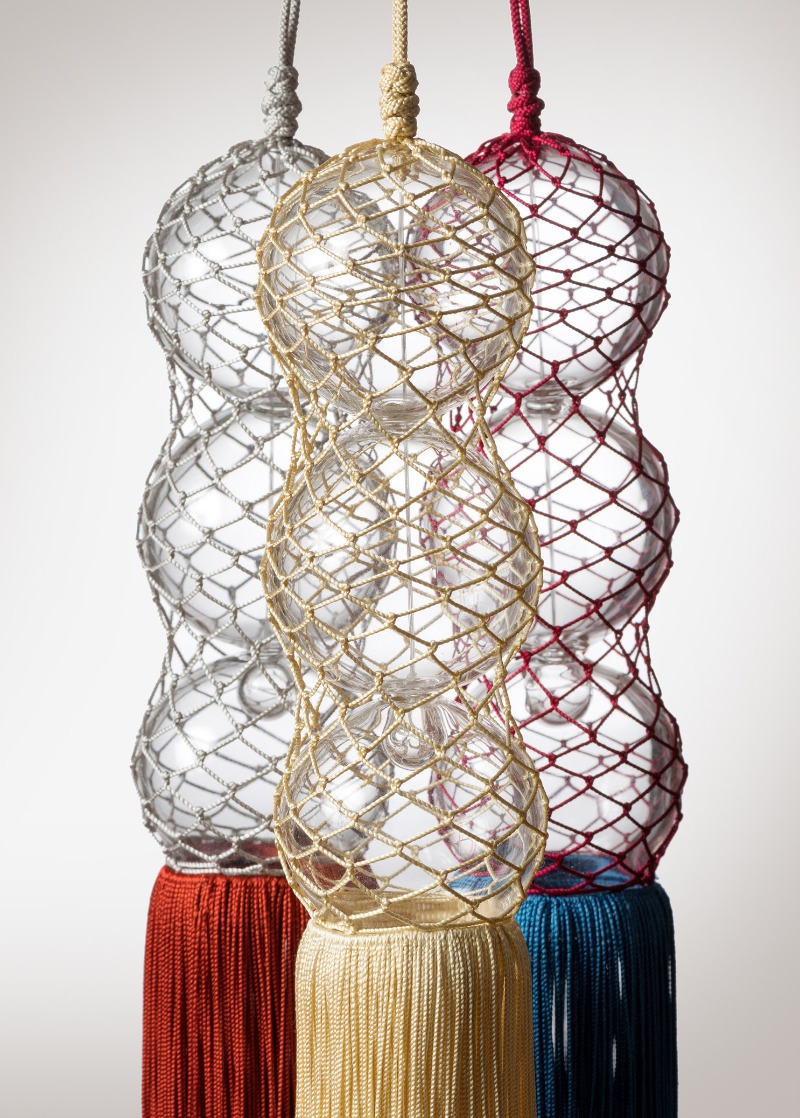
Works made with netting and tassels were submitted to the exhibition “Jemang jungjung” (meaning “Buddha’s nets cast repeatedly to save the world”) held at Seongnam Art Center in August 2021. Steeped in Buddhist symbolism, these accessories once worn by royal women (called samcheonju, or “three thousand beads”) had three large pearls tied with knots. To add a modern touch, Park used glass beads instead of pearls and held them in netting woven in the traditional way.
ⓒ Korea Cultural Heritage Foundation
Lee Gi-sookFreelance Writer
Lee Min-hee Photographer